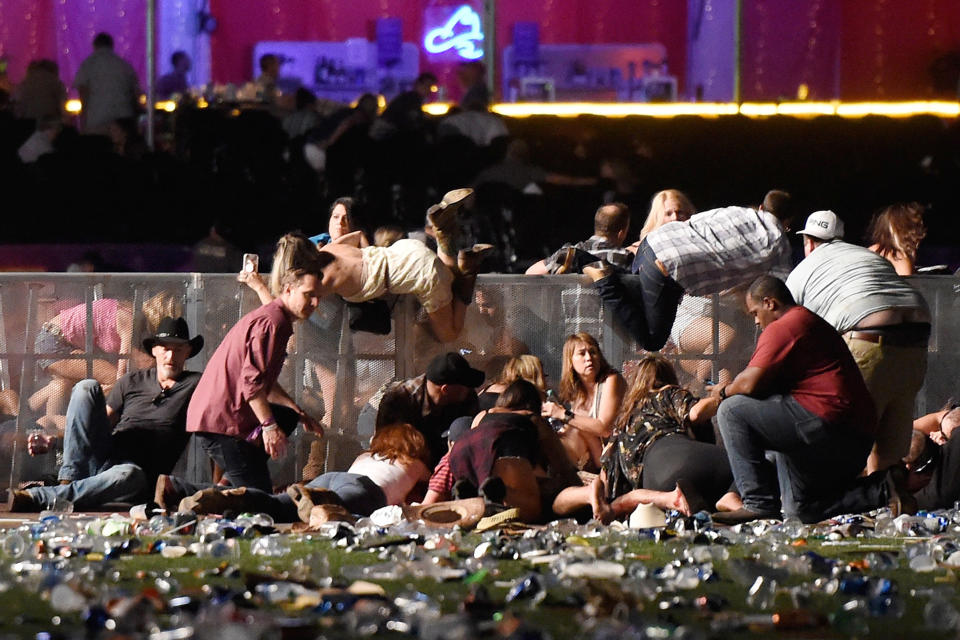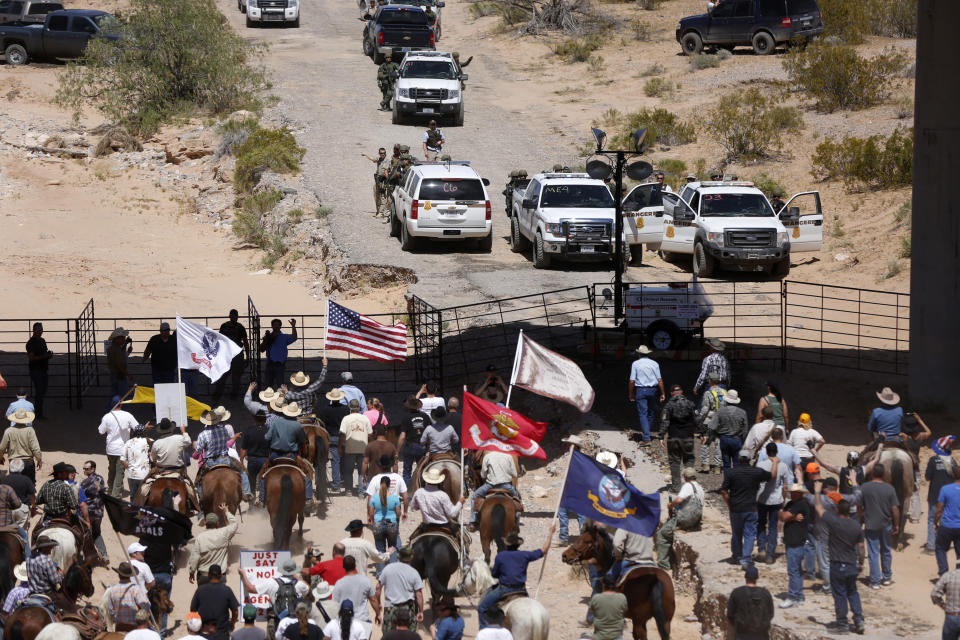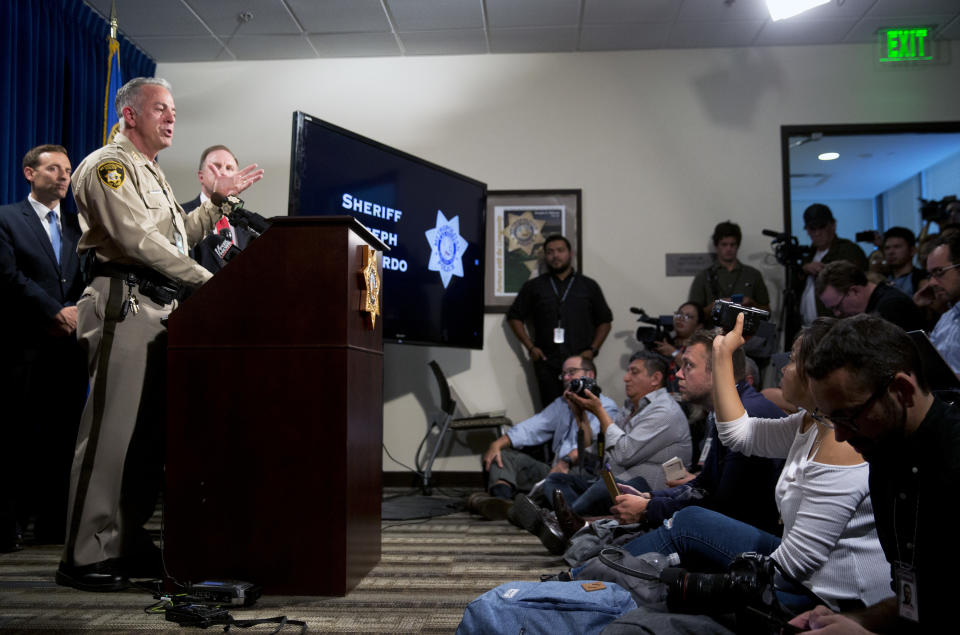Las Vegas sheriff, in emotional press conference, admits he's still searching for answers
Joe Lombardo was having a late dinner with friends from out of town when his cellphone suddenly blew up with messages. Shots had been fired on the south end of the Las Vegas Strip, about 10 minutes from where he was. With a few rushed apologies, he stood and ran out, hoping it would be only a minor diversion.
It took just seconds for Lombardo, the Clark County sheriff, to realize this would be no ordinary Sunday-night call. As he rushed past unsuspecting crowds illuminated by the flashing lights of the casinos along the north end of the Strip, radio traffic revealed chaos mere blocks away outside the Mandalay Bay Resort and Casino, where officers and thousands of attendees at a country music concert were being sprayed with gunfire by an assailant whose location was not yet known.
Nearly two weeks later, Lombardo still doesn’t have the answers he has been seeking ever since, to the how and, more important, the why of the horrific attack. But at a press briefing Friday afternoon that clarified some of the events of that night, while raising new questions, the stoic lawman gave vent to some of the emotions that have been roiling him ever since.
As he approached the scene, Lombardo saw hundreds of people running for their lives up Las Vegas Boulevard and along the side streets and in parking lots, some covered in blood. By then the shooting had stopped, and his officers were closing in on the suspected gunman, later identified as Stephen Paddock, who was holed up on the 32nd floor of Mandalay Bay. But the horror was far from over. Lombardo’s radio crackled with word of casualties, including reports of dozens of lifeless bodies in and around the Route 91 Harvest Festival concert grounds and word that some of his responding officers were down, wounded by gunfire when Paddock apparently took aim at law enforcement responding to the scene. There were also reports, later dispelled, of shots being fired at other nearby casinos along the Strip.

Slideshow: Scenes from Las Vegas mass shooting >>>
For Lombardo, a 29-year veteran of the Las Vegas Metropolitan Police Department, it was the nightmare he had always feared, the one he had tried to prepare his department for. He had methodically studied mass shootings, including the 2015 terror attack in San Bernardino, Calif., and the Pulse nightclub shooting last year in Orlando, to heed lessons for his own officers. He had even traveled to Mumbai, India, to study firsthand the 2008 terrorist attacks where 164 people were killed in a series of coordinated strikes against hotels and other public spaces — aware that terrorist groups had long mentioned Las Vegas as a possible target.
But one of his biggest concerns as sheriff, he told the Las Vegas Sun in 2015, was a “lone wolf” attacker. “The person here locally that is disgruntled with government, separatist, anarchist, those types of individuals,” Lombardo said. Someone, he said, willing to act “on their own.”
As Lombardo later told reporters, even though his officers were doing everything they had been trained to do that Sunday night in reaction to a mass shooting event, nothing had fully prepared him or anyone to be confronted with this type of horror on their own doorstep.
“It just kept getting worse and worse,” Lombardo told KLAS-TV, the CBS affiliate in Las Vegas.

In the nearly two weeks since Paddock broke the windows of his suite at Mandalay Bay and rained gunfire on roughly 22,000 concertgoers below, killing 58 and injuring more than 540, Lombardo has become the face of the ongoing investigation. Plain-spoken, with a matter-of-fact delivery, the sheriff has been the primary conduit of information for his community and the television audience at large from around the world as people grapple for answers to why Paddock created such carnage.
Lombardo has won praise for his down-to-earth, even-keeled demeanor, and seems more forthcoming than other law enforcement officials, including the FBI, who have publicly spoken about the case. He has insisted on “telling the public what I know when I know it,” as he explains it, to “provide calmness in the community.”
While Lombardo has warned the media and others against speculation, he has been open about his own theories. He has repeatedly questioned how Paddock, a 64-year-old real estate investor and avid gambler, could have planned the attack with no one noticing or helping.
“Do you think all of this was accomplished on his own?” Lombardo said at a briefing last week. “Face value, you’ve got to make the assumption that he had to have help at some point.” He said “it would be hard for me to believe” that Paddock did all the preparations totally on his own.
The sheriff has also said he believes Paddock — who had 50 pounds of explosive material and another 1,600 rounds of ammunition in his car, parked in the casino’s garage — intended to escape. But he acknowledged that not everyone involved in the investigation agrees with him.

Lombardo has not tried to conceal his own frustration with the pace of the investigation. After nearly two weeks, police still have no clear motive for one of the worst mass shootings in American history. And as the mystery has deepened about Paddock, who had no record of mental illness or political or religious extremism, Lombardo has openly questioned whether a motive will ever be established.
“There’s a chance we may never know,” he told reporters this week. “There are questions that may never get answered.”
The investigation has cast a spotlight on the sheriff, who, according to those who know him, does not enjoy the limelight. Lombardo, 54, was born in Japan. His father, a sergeant in the Air Force, was transferred to Nellis Air Force Base in Las Vegas in 1976, when Lombardo was 14.
After high school, Lombardo joined the Army before enrolling at the University of Nevada-Las Vegas, where he got a civil engineering degree. But soon he followed his father, who had retired from the Air Force and joined the Las Vegas police department, into law enforcement. Lombardo joined the Las Vegas police in 1988 — and while working his way up the ranks, he got a master’s degree in crisis management from UNLV and from the FBI National Academy, both in 2006.
In 2014 Lombardo, a Republican, ran for and was elected Clark County sheriff — a job that, unlike in other big cities, involves running both the sheriff’s department and the Las Vegas Metropolitan Police Department. More than 3,500 officers report to him, and his jurisdiction spans roughly 8,000 square miles — including the city of Las Vegas and the rest of Clark County, which extends nearly 100 miles east toward the Utah border and 100 miles south toward Arizona.
While much of the land is unsettled desert or farmland, it has not been without drama. In 2014 Lombardo, as assistant sheriff, was the lead tactical commander in responding to a standoff between rancher Cliven Bundy and his supporters and officials of the Bureau of Land Management who had confiscated cattle that Bundy had been grazing on federal land. Lombardo helped negotiate the release of cattle, allowing the standoff to end peacefully.

As sheriff, Lombardo has grappled with restructuring a police department that has come under Justice Department scrutiny for its frequent police shootings and its relationship with the black community. In a high-profile event over the summer, Seattle Seahawks player Michael Bennett accused Las Vegas police of targeting him in a traffic stop because he was black and of using excessive force. Lombardo has said his officers acted properly but has allowed that more work needs to be done establishing trust between his department and the community.
But now Lombardo faces one of the biggest challenges of his career — heading an investigation of an incident in which a man appears to have taken deadly aim at people while leaving no obvious clues or explanation for why he did so. In the days since the Oct. 1 shooting, Lombardo has grown more and more outwardly frustrated in the search for Paddock’s motive.
“We still don’t know why,” Lombardo told reporters earlier this week. “And it’s not for a lack of trying.”
With that mystery comes increased scrutiny on other parts of the investigation — including on the police response to the shooting.
On Monday, Lombardo released a significantly revised timeline of the shooting, indicating that Paddock shot a hotel security guard six minutes before he started firing on concertgoers. The timeline, which was disputed by MGM Resorts, the owner of Mandalay Bay, raised questions about why it took police so long to locate the gunman, and a possible failure in communication between officers and Mandalay Bay, which presumably would have reported that one of its guards had been shot.

On Friday, Lombardo corrected the timeline once again — bristling at what he described as people in “cyberspace” questioning the integrity of not only his investigation but his own personal integrity. “I provided you the information as I knew it, and everybody in here knew it was going to change,” he said, visibly irritated. “The dynamics of this investigation are far-reaching. It’s wide. It’s huge, and you can’t expect exact answers in the early throes.”
In their initial account police said the security guard, Jesus Campos, was shot around 10:15 p.m. — about 10 minutes into the attack — when Paddock discharged a volley of gunfire through the door of his room after seeing Campos approach on a baby monitor the shooter had placed on a room service cart. Police had originally portrayed Campos as a hero, telling reporters he had interrupted and stopped the killing and alerted law enforcement about the location of Paddock’s room.
But on Monday police said Campos, who was unarmed, was shot and wounded at 9:59 p.m. as he investigated an apparently unrelated alarm for an open door on the floor — six minutes before Paddock began firing out his window at 10:05. Police now say they have no idea why Paddock, who had a large quantity of ammunition and other loaded weapons in his room, stopped his rampage 10 minutes later.
Lombardo said Campos had alerted Mandalay Bay security that he had been shot, but police hunting for the gunman learned this only when they found him lying wounded in the hallway. By that time Paddock had stopped shooting.
According to the updated timeline released Monday, police officers reached the 31st floor of the resort and casino at 10:12 p.m. — where, they reported to colleagues, they could hear shots being fired above them. Officers reached the 32nd floor, where Paddock was staying in Room 135, at 10:17, two minutes after he stopped shooting. They found Campos a minute later, at 10:18 p.m., and the security guard pointed them to Paddock’s room. Police did not breach Paddock’s room until 11:20 p.m. — more than an hour later — where they found him dead of a self-inflicted gunshot wound.
But that timeline was disputed by MGM Resorts, which released a statement Thursday saying the 9:59 p.m. report was “not accurate.” “We know that shots were being fired at the festival lot at the same time as, or within 40 seconds after, the time Jesus Campos first reported that shots were fired over the radio,” the statement read. “Metro officers were together with armed Mandalay Bay security officers in the building when Campos first reported that shots were fired over the radio. These Metro officers and armed Mandalay Bay security officers immediately responded to the 32nd floor.”

On Friday Lombardo defended the revised timeline, specifically regarding the 9:59 p.m. time print, but said “circumstances associated” with it had changed and the police timeline was “not in conflict” with the MGM Resorts statement. The sheriff explained that a “human entry” in a hotel security log provided to police had listed 9:59 p.m. as the moment Campos had first encountered Paddock. But he said it now appears that the entry marked the time when Campos, attempting to reach the 32nd floor, discovered that a stairwell door near Paddock’s room had been barricaded.
Unable to access the floor from that stairwell, Campos, according to Lombardo, took another route, and was actually shot at 10:05 p.m., about the same time when Paddock began taking aim at concertgoers outside his window.
But the sheriff did not clarify remaining questions, including what time Mandalay Bay officials alerted police that Campos had been shot or why it still took 12 minutes for cops to make it to the 32nd floor. On Friday, Lombardo repeated that Campos alerted security at Mandalay Bay of the gunfire — via both radio and his cellphone. But, uncharacteristically, he declined to take follow-up questions.
Lombardo, who has declined most national media requests except for an appearance on “60 Minutes” that aired last Sunday, was unapologetic about the changing facts of the case. And he pushed back against criticism that the shifting timeline was evidence of “incompetence” or “conspiracy” by his department.
“I am absolutely offended by that characterization,” he insisted. “There is no conspiracy. … Nobody is attempting to hide anything.”
The details, he added, are likely to change again.
In the 12 days since the shooting, Lombardo says he hasn’t slept much. A few hours here, a few hours there — mostly on a ragged old couch in his office at police headquarters. He and others have been combing through more than 1,000 tips from the public, trying to answer the mystery behind why someone who had led an otherwise unremarkable life would suddenly become a mass killer.

“Part of me losing sleep is, did I miss something? Did I fail to do something? Did my people fail to do something?” he told the Las Vegas Review-Journal on Tuesday. “You immediately think you’re gonna know the reasons why in the short term. Now, here we are a week after the fact, and we still don’t know.”
On Friday, 12 days after the shooting, the sheriff looked and sounded exhausted. And after days of being matter-of-fact and in control, he became visibly emotional discussing officers who had selflessly run toward the scene to save lives, even as the bullets continued to rain down. Several officers, he said, were severely wounded when Paddock began shooting at them as they drove up to the scene — a diversion that injured them, but likely saved the lives of others.
One of the officers, Brady Cook, had four gunshot wounds, including in the chest. “The reason I bring him up,” Lombardo said, choking back tears, “is because he asked me if he could come back to work today.”
The sheriff paused, trying to regain his composure. “Excuse me for my emotion,” he said, his voice quivering.
_____
Read more from Yahoo News:


